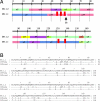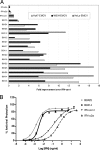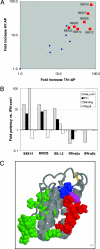Directed evolution of gene-shuffled IFN-alpha molecules with activity profiles tailored for treatment of chronic viral diseases
- PMID: 17494769
- PMCID: PMC1895939
- DOI: 10.1073/pnas.0609001104
Directed evolution of gene-shuffled IFN-alpha molecules with activity profiles tailored for treatment of chronic viral diseases
Abstract
Type I IFNs are unusually pleiotropic cytokines that bind to a single heterodimeric receptor and have potent antiviral, antiproliferative, and immune modulatory activities. The diverse effects of the type I IFNs are of differential therapeutic importance; in cancer therapy, an enhanced antiproliferative effect may be beneficial, whereas in the therapy of viral infections (such as hepatitis B and hepatitis C), the antiproliferative effects lead to dose limiting bone marrow suppression. Studies have shown that various members of the natural IFN-alpha family and engineered variants, such as IFN-con1, vary in the ratios between various IFN-mediated cellular activities. We used DNA shuffling to explore and confirm the hypothesis that one could simultaneously increase the antiviral and Th1-inducing activity and decrease the antiproliferative activity. We report IFN-alpha hybrids wherein the ratio of antiviral:antiproliferative and Th1-inducing: antiproliferative potencies are markedly increased with respsect to IFN-con1 (75- and 80-fold, respectively). A four-residue motif that overlaps with the IFNAR1 binding site and is derived by cross breeding with a pseudogene contributes significantly to this phenotype. These IFN-alphas have an activity profile that may result in an improved therapeutic index and, consequently, better clinical efficacy for the treatment of chronic viral diseases such as hepatitis B virus, human papilloma virus, HIV, or chronic hepatitis C.
Conflict of interest statement
The authors declare no conflict of interest.
Figures




References
-
- Pestka S, Krause CD, Walter MR. Immunol Rev. 2004;202:8–32. - PubMed
-
- Foster GR, Masri SH, David R, Jones M, Datta A, Lombardi G, Runkell L, deDios C, Sizing E, James MJ, Barelli-Berg FM. J Immunol. 2004;173:1663–1670. - PubMed
-
- Hibbert L, Foster GR. J Interferon Cytokine Res. 1999;19:309–318. - PubMed
-
- Kurtzman AL, Govindarajan S, Vahle K, Jones JT, Heinrichs V, Patten PA. Curr Opin Biotechnol. 2001;12:361–370. - PubMed
-
- Kowdley KV. J Clin Gastroenterol. 2005;39:S3–S8. - PubMed
MeSH terms
Substances
LinkOut - more resources
Full Text Sources
Other Literature Sources
Medical

